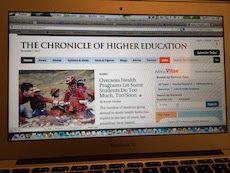I mostly buy into the theory that one reason newspaper organizations have typically made modest rather than big bets on new digital businesses is the wild success they enjoyed over decades under their old model.
So when Michael Riley, installed in May as CEO and editor-in-chief of the Chronicle of Higher Education, told me 10 days ago that it was launching what he hopes will be a breakout new digital service, I wanted to hear more. In its little bailiwick, the Chronicle has had as sweet a sustained run of business and editorial success as any newspaper I can think of.
Nearing its 50th birthday, the publication had the equivalent of a garage start-up. Corbin Gwaltney, the editor of the John Hopkins alumni magazine, organized his peers at other elite colleges to pool coverage of trends and happenings in the academy. That soon expanded to a weekly newspaper covering higher education nationally.
Recruitment classifieds were a natural fit. And the Chronicle caught a huge tailwind as tough federal equal opportunity requirements were introduced in the 1970s. A prominent ad in the Chronicle became the gold standard for universities to prove that they were conducting open searches in picking among candidates for vacant positions.
That business has held up remarkably well. Riley told me the Chronicle had 81 pages of print recruitment ads in its Sept. 6 issue.
Nor was the publication late in offering a website (by the mid 1990s) and, soon after, digital subscription alternatives. As of June, the Chronicle had 39,000 print subscribers at $89 a year and 21,000 digital subscribers to an e-replica edition at $78 a year, Riley said. All of those get full access to the website, and the Chronicle sells an additional 1,400 licenses to schools that then can give all faculty a ticket into the site. Traffic stands at 2.1 million unique visitors a month.
With all those pluses, the Chronicle has been seeing a small slide in both circulation and print advertising over recent years. So it recruited Riley — a digital veteran with stops at Time, The Roanoke Times, CQ and Bloomberg Government — to take the reins with a mandate to carry out bigger digital innovations more quickly.
First in a series of such projects, Riley told me, is ChronicleVitae.com, a recruitment/career site built to accommodate the special features of the academic job market.
LinkedIn and other generic career sites do not work so well for college teachers and administrators, Riley said. For a start, a curriculum vitae (CV) — unlike a catch-the-recruiter’s-eye resume — is better if lengthy. These days, job candidates assemble a complex dossier besides that long list of published work and conference presentations. The new site provides free organizational tools for all those materials and ways to edit and update them. It also works for tenure applications or establishing connections to peers with similar interests.
“We have been doing career news and advice right along,” Riley said, “but we want to create more and smarter content of that kind.” A recent example: “Googling for Grant Dollars.”
I asked Riley about revenue. “There is no revenue story yet,” he said. “The first step is to build the community, then there will be ways to make money” — advertising, sponsorships, events, related premium products.
The project had six months of development when Riley joined the organization. He put it at the front of the line and brought it to market in the six months he has been there.
Riley described his management strategy, if not exactly digital first, as “digital forward.” He said, “My view is that our business is at an inflection point. Print has been great and will remain a huge source of revenue. But there is a need for transformation in how to serve this community — deeper thinking and creativity in small ways and big ways.”
My affinity for the Chronicle started in the 1990s, when I worked on higher education public policy and read it faithfully. Stories were reliably well-reported, well-written and imaginative in framing trends and issues.
That is still part of the culture, Riley said. Founder Gwaltney, now in his early 90s, remains active and insists on keeping up quality. “About 50 percent of our 200 employees (including those at the sister Chronicle of Philanthropy), are journalists,” Riley said. “That compares to the 12 percent or so budgeted to the newsroom” at a typical newspaper.
I’m not here to say that ChronicleVitae is assured to succeed. It could be sound as a concept but fail to catch on (like RSS feeds, for instance). Or it could develop healthcare.gov-like operational glitches.
But the venture checks many of the right boxes — based on a deep knowledge of the audience and its needs, ambitious and fully digitally based, with enough financial runway, as Jeff Bezos likes to say, to find its legs.
Individual newspaper organizations and the industry continue the protracted search for a next big thing in the digital realm. After years of watching the effort, I’m still not sure what that would be.
(Disclosure: Riley is a professional friend and a member of Poynter’s National Advisory Board).







